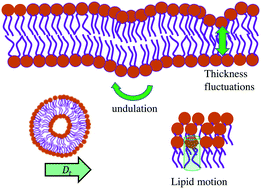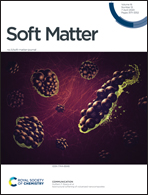Modeling the dynamics of phospholipids in the fluid phase of liposomes†
Abstract
We present the derivation of a new model to describe neutron spin echo spectroscopy and quasi-elastic neutron scattering data on liposomes. We compare the new model with existing approaches and benchmark it with experimental data. The analysis indicates the importance of including all major contributions in the modeling of the intermediate scattering function. Simultaneous analysis of the experimental data on lipids with full contrast and tail contrast matched samples reveals highly confined lipid tail motion. A comparison of their dynamics demonstrates the statistical independence of tail-motion and height–height correlation of the membrane. A more detailed analysis indicates that the lipid tail relaxation is confined to a potential with cylindrical symmetry, in addition to the undulation and diffusive motion of the liposome. Despite substantial differences in the chemistry of the fatty acid tails, the observation indicates a universal behavior. The analysis of partially deuterated systems confirms the strong contribution of the lipid tail to the intermediate scattering function. Within the time range from 5 to 100 ns, the intermediate scattering function can be described by the height–height correlation function. The existence of the fast-localized tail motion and the contribution of slow translational diffusion of liposomes determine the intermediate scattering function for t < 5 ns and t > 100 ns, respectively. Taking into account the limited time window lowers the bending moduli by a factor of 1.3 (DOPC) to 2 (DMPC) compared to the full range.



 Please wait while we load your content...
Please wait while we load your content...
